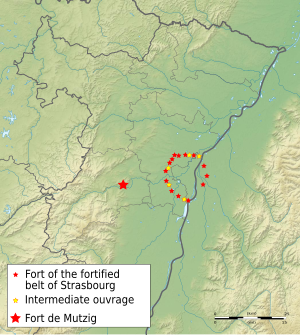Fort de Mutzig
| Fort de Mutzig | |
|---|---|
| Part of German fortifications of Strasbourg | |
| France | |

Location of the Fort de Mutzig and the fortified belt of Strasbourg, which together formed the German defense line on the Bruche, also known as Breuschstellung.
|
|
| Coordinates | 48°32′52″N 7°27′41″E / 48.547778°N 7.461389°E |
| Type | Fort |
| Site information | |
| Controlled by | Germany |
| Open to the public |
Yes, not in totality |
| Site history | |
| Built | 1893 |
| Materials | Concrete, steel |
| Garrison information | |
| Current commander |
French army |
| Garrison | 6500 |
The Fort de Mutzig, also known as Feste Kaiser Wilhelm II, is located near the town of Mutzig, in the Bas-Rhin department of France. It is one of the fortifications built by Germany at the end of the 19th century to defend Strasbourg.
It was the first new fortification built in what was then German territory after the invention of high explosives, which rendered earlier masonry fortifications obsolete.
Fort de Mutzig was part of a network of forts surrounding Strasbourg and Metz that had been built by the Germans after the end of the Franco-Prussian War. Earlier forts built from 1872 to 1880 used masonry, which did not resist high explosives, or concrete. The Mutzig works were planned as a demonstration of new technology.
The western fort, built in 1895, was built of concrete from the beginning, while the 1893 eastern fort, which had been built in masonry, was reinforced and covered in concrete. Armored observation points and 150mm howitzer turrets were installed, while Mutzig was the first German fort with its own electricity generating plant. It also was equipped with a radio link to Strasbourg, infantry shelters and underground living quarters. Costs were estimated at 15 million marks.
The fortifications comprise three main portions. The newest section, and the place used for tours, is located in the northwestern fort. The 1895 west fort is located somewhat to the south, and the eastern fort about one kilometer to the east of the western fort. Together they comprise a Feste, or fortification, a concept which was later developed in the construction of the French Maginot Line fortifications.
In 1914, the 254-hectare (630-acre) fort comprised 50 buildings, with an underground space of approximately 40,000 square meters (400,000 square feet). With 22 turrets equipped with 10 cm and 15 cm howitzers at a maximum rate of fire of 6.5 tons of shells per minute, Mutzig was one of the strongest forts in Europe. 8,000 troops of the German army manned the defenses of Strasbourg at the time. Forces were disposed in the ring of forts around Strasbourg, as well as the Vosges mountains for defense against French forces around Belfort.
...
Wikipedia

